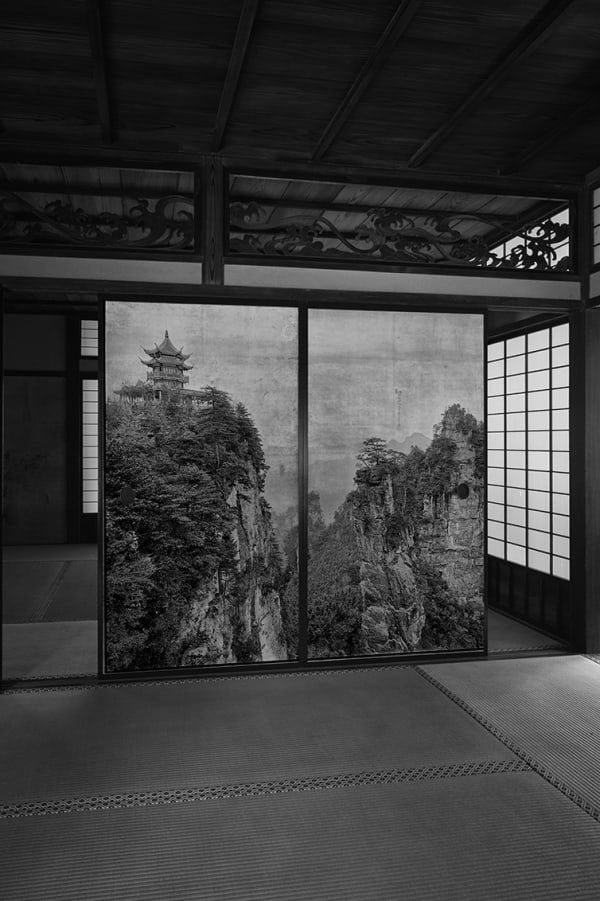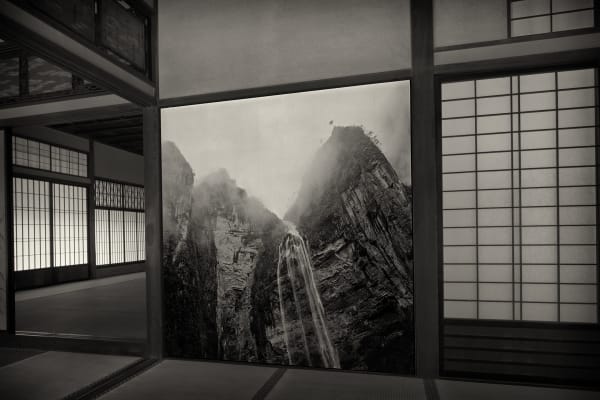Synthesis: Japanese Fusuma Photography by Kenji Wakasugi
Wakasugi combines views of nature he has photographed while traveling the remote regions of the world with fusuma, decorated sliding doors. These particular fusuma have been taken from a Japanese room with over four hundred years of history, and his photographs have been artfully inserted into them. This represents a synthesis of opposing worlds—of interior and exterior, light and dark, stillness and motion, film and digital, old and new.
Fusuma are a form of spatial device employed in traditional Japanese architecture. These sliding doors are comprised simply of wood and paper and although flimsy and have no locks, they represent a spiritual boundary, separating one side from the other, absolutely. Japanese rooms are not divided physically with walls, but spiritually, using fusuma; this allows people to interact freely with the space, sometimes removing these fusuma to create a large hall or reinserting them to produce a small room. Fusuma also respond gently to nature, reflecting the four seasons. The pale brush-and-ink paintings illuminated by mid-day’s light reflecting off the tatami mats on the floor; the gold and silver leaf in designs that appear to float bewitchingly in the light of the moon; all transmitting the poetic charm of the period. The 16th century artist, Kano Eitoku, sublimated these household fittings into art through his magnificent brushwork and the Japanese people experience a microcosm of nature through these paintings, in which a unique, two-dimensional expression of the world unfolds. This synthesis of art and nature on the doors dividing a space may be said to spring from the Japanese views of life and death.
Wakasugi says that poetic sentiment exists in the space between memories.
Using digital technology to boldly remove the paintings applied to the fusuma by the artists of the past, he carefully replaces them with his own photographs, creating a time and space that does not exist in reality, thereby challenging the past.
I think it is no exaggeration to say that Wakasugi Kenji’s photographs inherit the traditions of the gorgeous world of fusuma painting that were developed by such great artists as Tawaraya Sōtatsu or Ogata Kōrin.
Shoko Aono
This March, Ippodo Gallery will showcase the fusuma photography of Kenji Wakasugi at both the Tokyo and New York gallery locations. Coinciding with Asia Week New York, the stateside exhibition is Wakasugi’s first-ever solo show outside Japan. 2016 marks the 20th anniversary of Ippodo Gallery in Japan, and its 8th year with a gallery here in New York.
The photographs on view pair Edo-Period (16031868) fusuma - decorated paper doors used in traditional Japanese buildings - with landscape and nature photographs. The fusuma doors used were sourced from the 17th century feudal domain Kishū (from the Rinshun-kaku, which has since been relocated to the Sankeien Garden in Yokohama and is a designated Important Cultural Property of Japan), once belonging to the eminent and long-powerful Tokugawa family.
Wakasugi (born 1941) drew inspiration from Junichirō Tanizaki’s essay, ‘In Praise of Shadows’, an eloquent aesthetic analysis. Tanizaki writes, “We find beauty not in the thing itself but in the patterns of shadows, the light and the darkness, that one thing against another creates...Our ancestors, forced to live in dark rooms, presently came to discover beauty in shadows, ultimately to guide shadows toward beauty’s ends.” The quote is soft and sensitive, not unlike Wakasugi’s photography.
The fusuma images are juxtaposed with landscapes and nature photography in a delicate balance achieved through a lengthy, painstaking process of digital artistry. The distinct pairing is a contemporary comment on reverence for tradition. Wakasugi explains that, “as the world rushes towards globalization, I find myself becoming more attracted by Japan’s unique culture and customs.”
In Wakasugi’s work, the historic locations are selected for their lack of electricity to emphasize only the original, natural light of 17th century Japan. In fact, fusuma paintings are best seen with natural light, candlelight, moonlight, or tatami reflection. This world of shadow is an essential place in Japanese tradition. Fusuma has been the canvas in Japanese art history - an aesthetic and philosophical expression and a way to communicate on life and death. Fusuma is a reverse concept of culture and sensibility in space, both a barrier and a connection to spirituality in nature.
Landscapes are carefully chosen for their dual endurance and fragility. One lone pine tree in Rikuzentakata City survived the great tsunami in 2012. With nostalgic experiences in the Himalayas, travels across the valleys of China and the vistas of Patagonia in South America, Wakasugi has chosen to pair the fusuma with his unforgettable sights so that they may live forever.
Wakasugi was educated at Saga Prefectural Karatsu West High School and what is now known as the school of Tokyo Visual Arts, working at Roppongi Studio in Tokyo before going freelance in 1975. His first photobook, My Shangri-La, was published by Hirakawa Publishers in 1996, followed by an exhibition of the same name at Canon Salon in Ginza, Tokyo. Since then, Wakasugi has been recognized with an award from the Art Directors Club in New York, exhibitions at the Japanese Embassy in Belgium, and Nikon Salon in Ginza, Tokyo.














